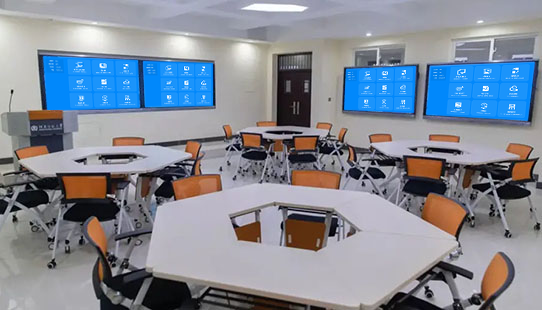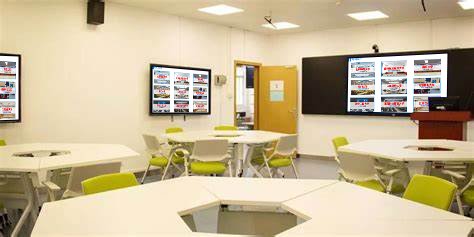Use This for Interactive Classrooms: More Efficient Teaching
Want to break away from the traditional one-way lecture model? This screen mirroring device effortlessly creates an interactive teaching environment! It’s compatible with teachers’ computers, students’ phones/tablets, and the classroom’s large display, supporting multi-device collaboration, real-time annotation, and content sharing. It’s perfect for elementary, middle, high school, and university settings, turning the classroom from a “passive listening” space into an “active participation” one, making teaching more engaging.
3 Steps to a Multi-Screen Setup: Easy for Teachers and Students
No need for complex classroom equipment renovations—a simple setup is all it takes to get started:
- Quick Hardware Connection: Plug the receiver into the main classroom screen/group sub-screen, and plug the transmitter into the teacher’s computer. Students scan the unique class QR code displayed by the device with their phones/tablets to connect in just 10 seconds, with no need for complicated network debugging.
- Permission Settings: The teacher can tap a button on the device’s backend to enable “Teaching Mode,” which automatically assigns “Teacher Master Control” permissions (for pushing lessons and controlling the pace) and “Student Participation” permissions (for mirroring results and asking questions), preventing irrelevant content from interfering.
- Start Interaction: Click the “Interactive” button on the device. The teacher’s device, students’ devices, and the large screen instantly connect. Lessons, annotations, and assignments are synchronized in real-time. The entire process takes less than a minute, so even new teachers can quickly master it.
Core Advantages: Adapted for Teaching Needs, Deeper Interaction
Flexible Lesson Delivery, Controllable Pace
- Segmented Delivery for Focus: A teacher can use their computer to divide a lesson plan into segments like “Concept Explanation,” “Case Study,” and “In-Class Practice.” They push each segment one by one, preventing students from getting distracted by looking ahead. When projecting videos or animations, it supports fast-forwarding and pausing, allowing for flexible control of the pace to make abstract knowledge concrete.
- Multi-Device Synchronization: Lesson content pushed by the teacher is automatically synchronized to students’ tablets/phones for later review. When students encounter important content, they can take a picture of the screen and annotate it on their phone, then push it to their group’s sub-screen. This makes group discussions more focused and eliminates the need to pass textbooks around.
- Cross-Device Teaching Relay: When a teacher leaves the front of the classroom, they can use a tablet (connected to the device) to take master control, continuing to push lessons and annotate key points. They can interact with students at their desks without interrupting the teaching flow, providing more flexible classroom control.
Full Student Participation
- Efficient “Hand-Raised” Mirroring: After a group discussion, a student can tap the “Raise Hand to Mirror” button on their phone/tablet. The teacher can then approve it with one click on the device’s backend, allowing the student to project their mind map or problem-solving steps to the main classroom screen or their group’s sub-screen for everyone to review. It also supports 2-3 groups displaying content on a split screen simultaneously, allowing for cross-group idea comparison and fostering a sense of healthy competition.
- QR Code for Easy Review: The device automatically generates a unique QR code for the student’s presentation and the teacher’s annotations. Students can scan the code to save the content to their personal learning space, making it easy to review without having to rush to copy notes.
- Seamless Remote Student Integration: Students learning from home can connect to the device via their phone/computer, watch the class content in real-time, and submit their work. They can participate in the interaction alongside in-person students, ensuring continuity in teaching.
Real-time Collaborative Interaction
- Shared Annotations: A teacher can use a writing tablet to circle key points and add notes to the mirrored content. These annotations are synchronized in real-time to all student devices. Students can also annotate questions on their own devices (e.g., “I don’t understand this formula”) and push them to the teacher’s device for targeted explanations, preventing the “fear of asking questions” and avoiding knowledge gaps.
- Instant Classroom Feedback: A teacher can use the device to send “in-class quizzes” or “poll questions” to students. After they submit their answers, the results are displayed on the main screen in 3 seconds. The teacher instantly understands student comprehension and can adjust the teaching pace accordingly, avoiding the “one-size-fits-all” lecture style.
- Complementary Multi-Screen Linkage: The main classroom screen can display core lesson content, while a side screen projects supplementary materials (like lab principle documents or extra videos) via the device. This dual-screen linkage provides a more comprehensive learning experience. During group discussions, each group’s sub-screen can display its results, and in the summarization stage, a single click pushes them to the main screen for an organized presentation.

Adapting to All Educational Stages
Elementary & Middle School: Fun Interaction for Better Learning
- In a language arts class, a teacher can project a textbook illustration to the main screen, and students can mirror their own hand-drawn pictures for comparison, deepening their understanding of the text. In a math class, the teacher can project a geometric shape to the main screen, and students can use a tablet to drag the shape to demonstrate a proof, making abstract knowledge tangible.
- In an English class, the teacher can push listening materials to the classroom’s speakers. Students can scan a QR code on their phone to take a quiz, and the results are mirrored in real-time. The teacher can then focus on explaining the most common mistakes, boosting classroom efficiency by 50%.
Vocational Education: Intuitive Hands-on Learning
- In hands-on classes like auto repair or mechatronics, a teacher can project a video of equipment disassembly to the main screen, and students can follow the steps. If they have questions, they can use their phone to record a video of their work and push it to the teacher’s device, allowing the teacher to remotely annotate errors without having to check each student’s station, making guidance more efficient.
- In design courses, students can project their work from their computers to the main screen. The teacher can use a writing tablet to annotate suggestions (like “adjust the color scheme”), allowing for more precise feedback and deeper student understanding.
Higher Education: More Efficient In-Depth Discussion
- In a specialized class, a teacher can project a snippet of an academic paper to the main screen. Students can use their tablets to annotate their viewpoints and then push them to their group’s sub-screen for in-depth discussion. After summarizing, different viewpoints can be pushed to the main screen for a class-wide debate, fostering critical thinking skills.
- In a graduation project guidance class, a student can project their design proposal from their computer to the main screen. The teacher can use the device to project reference cases for comparison, providing more targeted guidance and helping students make revisions more efficiently.
Secure and Stable: Confidence for Schools
- Permission Control for No Interference: You can set permissions like “only teachers can project during class” or “student mirroring requires approval” to prevent students from sharing irrelevant content. You can also create device groups by class, so different classes’ devices don’t interfere with each other.
- Stable, Lag-Free Transmission: Using dual-band transmission technology (2.4GHz + 5.8GHz), the latency is ≤20ms even with many devices connected simultaneously. Lessons and videos play smoothly, with a disconnection rate of less than 0.1%, ensuring no interruptions during class.
- Lightweight and Easy Maintenance: The device is plug-and-play and requires no complex installation. It supports a centralized management platform for schools to configure parameters and view usage data in bulk, keeping maintenance costs low. The casing is made of wear-resistant and anti-drop material, perfect for frequent use in classrooms.
By using this device to build an interactive classroom, teachers can transition from being “lecturers” to “facilitators,” and students can transform from “bystanders” to “participants.” It’s the perfect way to easily activate classroom vitality and help improve the quality of teaching.